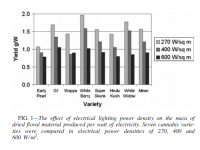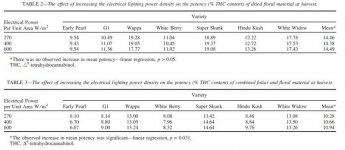D
DHF
Increasing wattage beyond 50 per sq ft has NEVER increased yields in ANY garden I`ve ever seen online or up close and personal Flat......Thanks for the thoughts guys! Good point Mister_D about the value of increased yield, but not all are medical/commercial growers. The "cost" I was trying to optimize was efficiency, not profit.
Speaking of which, if profit is your motive, wouldn't it be better to go way beyond 50 watts per sq. foot? I'd imagine that once you have temps and RH under control, you're always best pumping up the watts to as much as our space will allow in terms of increasing profits.
What increased wattage does is create constant environmental issues from excess transpiration to light bleaching/heat scorching and many other issues once you start chasing watts instead of settling for dialed everything runnin in sync and pumpin out the nuggage consistently.....
My 2 cents from all them yrs....
Peace....DHF....
 .....
.....




